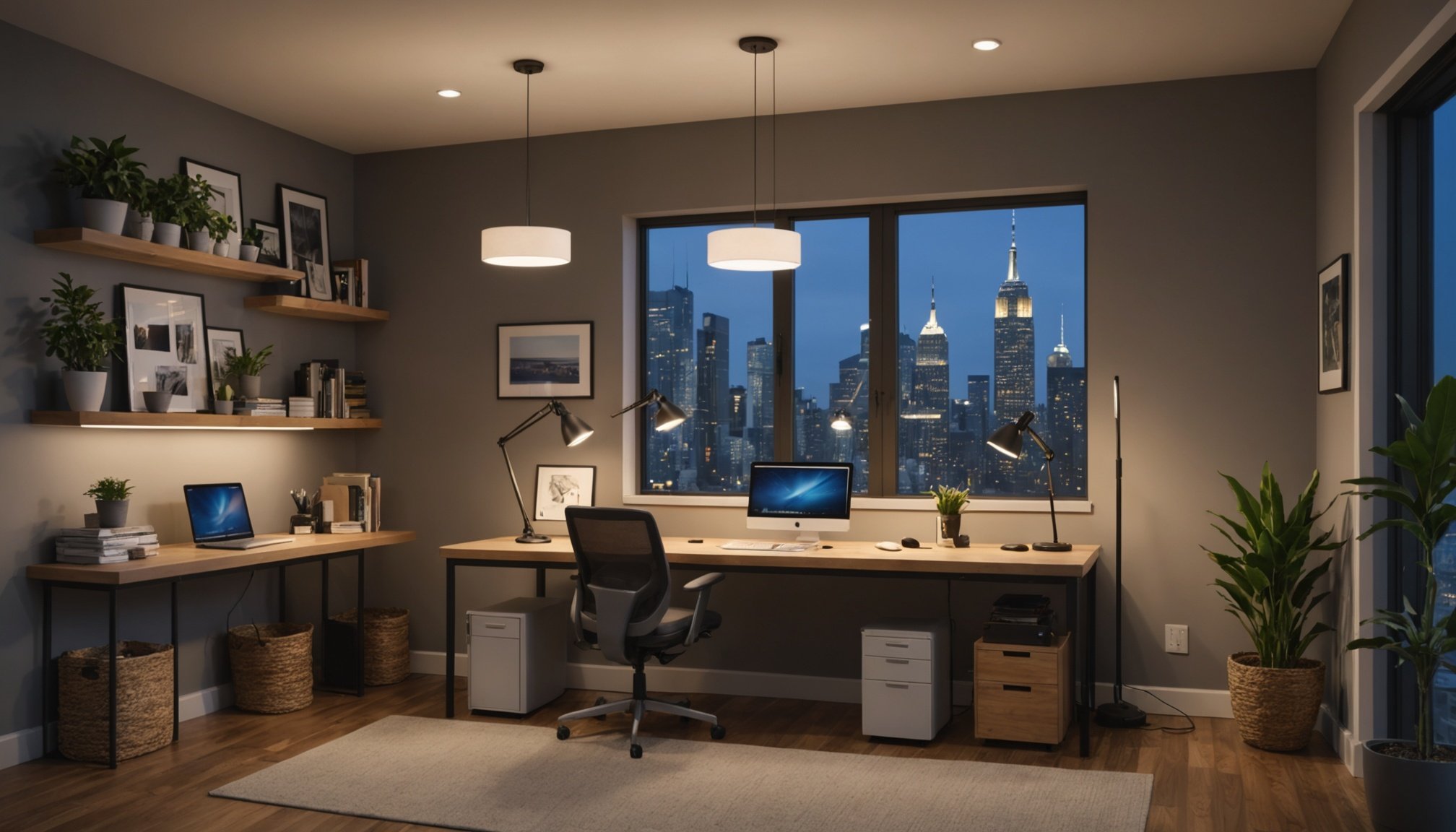Understanding Smart Lighting Solutions
Smart lighting goes beyond simply illuminating spaces; it offers sophisticated features designed to enhance mood and boost productivity. By allowing users to control color temperatures and lighting intensities, smart lighting can substantially impact one’s emotional well-being and work efficiency.
The core technology in smart lighting systems involves LED bulbs that can change color temperatures, from warm to cool, mimicking natural sunlight. This adaptability is crucial as it aligns with our circadian rhythms, promoting alertness during active hours and relaxation in the evening. For example, a cooler, bluer light can mimic daylight, helping to improve focus and productivity during working hours. Conversely, a warmer, redder tone in the evening can signal the body to unwind, aiding in mood enhancement.
This might interest you : Revolutionizing Finance: Quantum Computing’s Impact on Cryptography for Ultra-Secure Transactions
A notable feature of smart lighting is the ability to adjust lighting intensity and customize settings for different activities, whether for reading, working, or unwinding. Users can fine-tune their environment to match specific tasks, which can stimulate productivity or induce tranquility. Integrating these systems with smart home assistants can further streamline this process, providing seamless adjustments through voice commands or scheduled automation. Smart lighting serves as a versatile tool that accommodates changing personal needs throughout the day.
Benefits of Smart Lighting for Mood Enhancement
Lighting plays a crucial role in influencing our emotions and psychological state. Smart lighting systems offer tailored solutions for mood improvement by adjusting both color and intensity. Several psychological studies have demonstrated that specific lighting conditions can evoke emotional responses. For instance, a soft, warm glow can foster a sense of calm, while a brighter, cooler light encourages energy and alertness.
In parallel : Revolutionizing Water Purity: The Impact of Nanofiltration Technology on Future Purification Techniques
Customizing lighting to align with different times of the day or activities can significantly impact one’s emotional and psychological well-being. When engaged in relaxing activities, such as reading or winding down before bed, a warmer lighting setup can enhance tranquility. Alternatively, a cooler and more vibrant lighting scheme can be employed to invigorate and motivate during work-related endeavors.
Moreover, personalizing and customising your lighting environment isn’t just about mood enhancement—it’s about optimizing your surroundings to suit your lifestyle. Smart lighting systems provide the flexibility to cater to changing needs, whether it’s for an energetic start to the day or unwinding after work. By integrating these systems into your daily routine, you can harness the psychological effects of lighting, ultimately benefiting your overall mood enhancement.
Smart Lighting Options for Productivity
Smart lighting can significantly enhance productivity in your work environment. By providing tailored task lighting, these systems create an atmosphere conducive to focus and efficiency.
Customizing Your Workspace
Personalizing your workspace lighting is crucial for maintaining energy levels and clarity. Using smart lights, you can adjust brightness to suit your task, whether you’re tackling detailed work or broad brainstorming sessions. Consider employing lights that simulate natural daylight to boost alertness without straining your eyes.
Scheduling and Automation
Automation features allow seamless transitions in lighting throughout the day. Scheduling your lights to adjust from bright whites in the morning to softer tones in the evening can align environmental cues with your productivity needs. Smart bulbs and apps make it simple to automate these changes, removing the need for manual adjustments.
Recommended Smart Lighting Products
Leading brands like Philips Hue and LIFX offer versatile options, with products that range from single bulbs to comprehensive systems. These products come with user-friendly controls, enabling you to create an ideal mix of illumination for every task. Integrating these solutions can transform your workspace into an adaptable hub for increased productivity.
Installation Tips for Smart Lighting Solutions
When setting up smart lighting systems, the process can be straightforward with careful planning and some basic understanding of the technology. It starts with selecting the right smart bulbs and control systems that fit into your smart home integration.
First, ensure compatibility between your smart bulbs and the existing home’s network. Many popular brands offer user-friendly setup, requiring only a smartphone app to connect. A detailed installation guide that comes with the products can be invaluable for beginners.
Integrating smart lighting into home automation involves syncing with existing hubs or voice assistants like Alexa or Google Home. This can streamline the control, allowing voice commands to manage lighting settings efficiently.
Troubleshooting common issues, such as connectivity problems, often involves checking your Wi-Fi settings and ensuring devices are within range. Regular firmware updates for smart devices can also resolve many technical glitches.
By following these steps, you can achieve a seamless and user-friendly setup, bringing the convenience and benefits of smart lighting solutions to your home, enhancing both functionality and aesthetics.
User Testimonials and Case Studies
Smart lighting has demonstrated profound effects on user experience, as evidenced by numerous success stories from those who have integrated it into their lives. For instance, users often express how transitions in their lighting environment have directly contributed to noticeable mood improvements. Individuals have reported feeling more energized during the day and more relaxed in the evening, thanks to tailored lighting setups.
Moreover, productivity changes after the installation of smart lighting units can be quite remarkable. Many have shared before-and-after scenarios where their workspaces were transformed from mundane to dynamic, enhancing concentration and efficiency during tasks. This shift is often credited to the use of task lighting that adapts throughout the day, fostering an optimal work environment.
Feedback often highlights the effectiveness of smart lighting in not just altering the physical space but also impacting psychological and emotional states. The personalized lighting solutions allow users to structure their daily activities around their preferences, further showcasing the transformative power of smart lighting systems in everyday life.
Visual Examples and Design Concepts
Lighting is both a functional and aesthetic element in interior design, offering a unique opportunity to elevate any space. By strategically utilizing smart lighting design, you can achieve a harmonious balance between mood enhancement and practical illumination. Room designs that incorporate smart lighting often highlight the adaptive nature of these systems, showcasing their capability to seamlessly transition between warm and cool tones depending on the ambiance desired.
Visual comparisons in different environments emphasize how tailored lighting can completely transform a room’s atmosphere. An inviting living area might employ soft, warm lighting to induce relaxation, while a vibrant office space could benefit from dynamic, cooler lighting to stimulate productivity.
Designing with smart lighting doesn’t mean sacrificing style for functionality. Instead, it offers tips for integrating both, ensuring that the lighting does not only meet practical needs but also enhances the aesthetic appeal of your space. Mastering the combination of aesthetic lighting and smart technology can lead to stunning design concepts that cater to individual preferences and moods.
Data-Backed Insights on Lighting and Performance
Research reveals how lighting effects can substantially influence work efficiency. Recent studies indicate that adjusting light color temperatures to resemble natural sunlight can enhance focus and cognitive performance. Specifically, environments utilizing cooler, blue-tone lighting often report higher levels of concentration and alertness. This is crucial for tasks demanding sustained attention or high mental acuity.
Survey results highlight user satisfaction with smart lighting, especially when tailored for productivity boost. Users consistently report improved work environments due to adjustable task lighting, which aligns with their personal productivity rhythms. These findings underscore the value of smart lighting in creating optimal conditions for diverse work demands.
Longitudinal studies delve into the broader impact of lighting on overall well-being. Participants utilizing adaptive lighting systems note not only improved mood but also significant reductions in stress levels over time. The ability to automate changes in lighting intensity and color has been linked to enhanced emotional regulation, aligning light settings with daily fluctuations in mood and activities. This integrative approach offers a comprehensive solution that goes beyond mere illumination, addressing psychological and productivity needs through intelligent lighting design.










